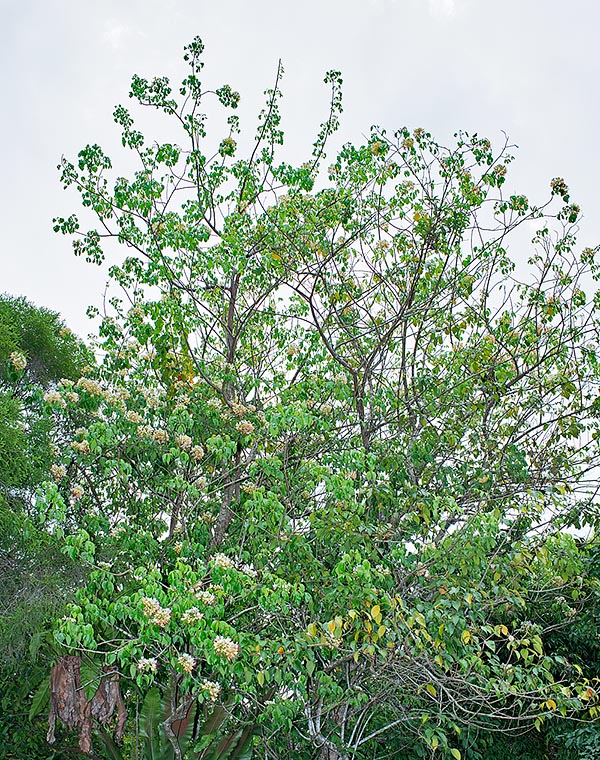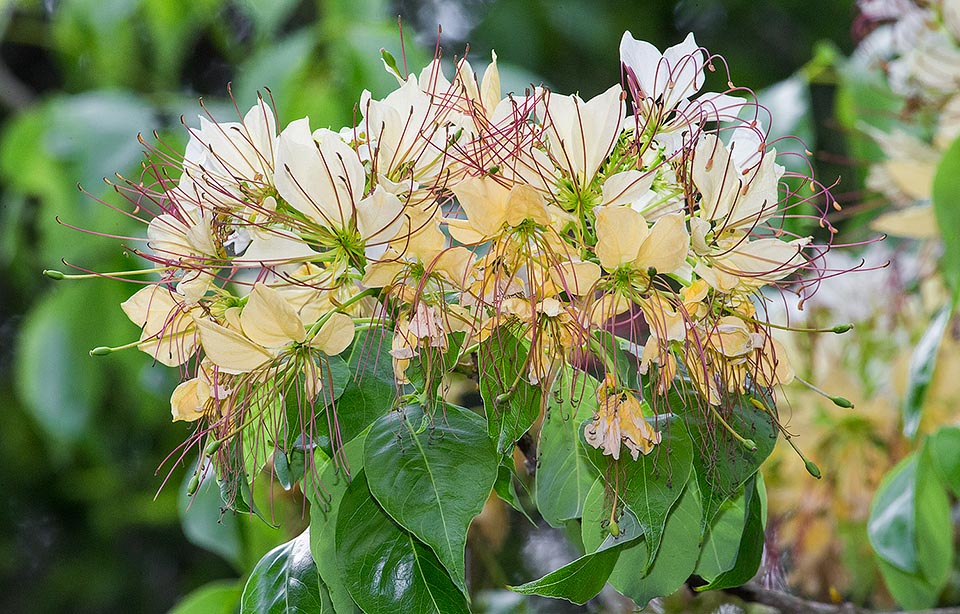Family : Capparaceae

Text © Pietro Puccio

English translation by Mario Beltramini

Crateva religiosa is a very ramified tree of India and of South-East Asia © Giuseppe Mazza
The name of the genus refers to Crateuas (or Cratevas), physician of Mithridates VI, King of Pontus (ca. 132-63 BC), author of the oldest known illustrated herbarium, of which text remain only the quotations of Pedanius Dioscorides (1st century AD) in his text De Materia Medica.
The specific name is the Latin adjective “religiosus, a, um” = religious, due to the meaning this tree has for the Hindus.
Common names: garlic-pear, sacred barma, sacred garlic-pear, templeplant, three-leaved caper (English); tonliem (Cambodia); yu mu (China); banugan, salingbobog (Philippines); gyo-boku (Japan); barna, bila, bilasi, cinnavulimidi, maredu, nervala, setu, tellavulimidi, usiki, varno, veruna, vayvarna, vitusi (Hindi); barunday, marana (Indonesia); kumz (Laos); dala, kepayan (Malaysia); hkan-tak (Myanmar); kum nam (Thailand); bún thiêu, bún lợ (Vietnam).
The Crateva religiosa G.Forst. (1786) is a very ramified tree, unarmed, deciduous, 3-15 m tall, with trunk, up to about 40 cm of diameter, with greyish wrinkled bark.
The leaves, on a 5-10 cm long petiole and grouped at the extremities of the branches, are alternate, trifoliate with elliptic-lanceolate leaflets with pointed apex and entire margin, 5-10 cm long and 2,5-5 cm broad, of green colour above, green grey below. Terminal corymbous inflorescences, on a 2-6 cm long peduncle, bearing 10-25 flowers, of 5-7 cm of diameter, rich of nectar, white or cream on the first day, tending orange yellow on the second and last day of opening. The flower is formed by 4 ovate sepals with pointed apex, 2-5 mm long and 2-3 mm broad, greenish, 4 unguiculate petals (petals with the long narrow base similar to a stem), 2-3,5 cm long and 1-2 cm broad, with ovate-elliptic lamina, 16-30 red-purple stamina with orange anthers, 3-7 cm long, and gynophore (peduncle supporting the ovary) 3-6 cm long.
The flowers are hermaphroditic, but self incompatible, therefore in need of crossed fecundation. The fruits are greyish obovoid berries with woody exocarp, 6-10 cm long and of 4-7 cm of diameter, containing numerous ellipsoid seeds slightly compressed, 1,5 cm long and 0,5 cm broad, immersed in a yellow pulp having a pungent smell of garlic.

Medicinal plant, for food and ornamental is often cultivated close to the temples and cemeteries due to the deep meaning it has for Hinduism followers © Giuseppe Mazza
Synonyms: Capparis magna Lour. (1790); Crateva magna (Lour.) DC. (1824); Crateva membranifolia Miq. (1861); Crateva brownii Korth. ex Miq. (1870); Crateva macrocarpa Kurz (1874); Crateva hansemannii K.Schum. (1888); Crateva speciosa Volkens (1901).
→ To appreciate the biodiversity within the CAPPARACEAE family please click here.
